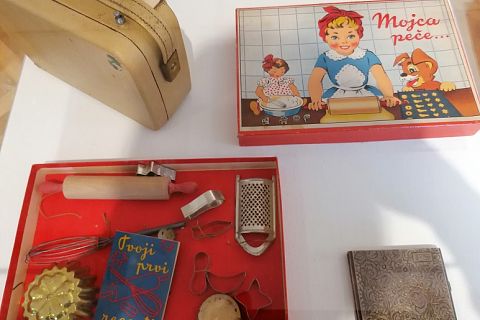Sociability in Kamnik from A to Ž
With the exhibition and the accompanying booklet, a kind of alphabet book Sociability in Kamnik from A to Ž, we tried to show fragments of the rich social life in municipality of Kamnik with the members of the study group.
As author Marko Kumer writes in the introduction to the booklet, the lapidary definition of social life was best summed up by Damjan Ovsec in his contribution “Philosophy” of social life in 2005 summarized it as follows: “Social life includes social events and games: human relationships in a certain environment and socializing due to an important personal, cultural, religious or sports event. Social life covers all strata of the population in cities and in the countryside and is an important part of social structure and culture. Forms of social life include home visits, visiting pubs, jour-fixes, dances, going to the theatre, cabarets, variety shows, concerts and cinemas, promenades, socializing on Saturdays and Sundays, trips and holidays, parties, games and competitions (e.g. playing cards, bowling, bowling, tombola), picnics, sports, hunting and fishing, literary circles, parties and birthdays, carnivals, main church holidays and processions, etc.”
It’s all pretty fun to read, but social life is very important. Sometimes you could simply be expelled for not being involved in normal social life. After the Second World War, there was a turning point: due to the negation of the bourgeois tradition, the rules changed drastically. Traces of bourgeois habits – ironically – can be seen in the representatives of the highest authorities of the socialist regime, very prominently, for example, in Josip Broz Tito and some of his more educated colleagues. Today, the leap from the analog to the digital age has caused the most radical changes in social life, or in its gradual abandonment.
With the exhibition and the booklet Sociability in Kamnik from A to Ž (Mainly the 1960s) we stopped at the time between 1957 and 1975 and the area of the town of Kamnik and its surroundings. It was created in cooperation with members of the study group Once upon a time in Kamnik, which led Marko Kumer in two school years, 2022/23 and 2023/24. Contributions to the book you are holding were written by the following members of the group: Tatjana Drovenik Čalič (School in Zgornje Tuhinj as a central place of sociability), Janez Trebušak (My confirmation), Frenk Vengust (Pri nebeškem očetu), Jelka Otrin (Šranganje na Prvomajski), Pavla Lah (Janez Vidmar, zither maker), Tina Petek – Steinbücher (Valley of Kamniška Bistrica) and Majda Tratnik (Graduation customs).
All the other members of the club during the last school year also participated creatively with many souvenir fragments, snapshots and photographs: Helena Sterle, Vlasta Prelog, Zvonka Šenica, Milena Urankar, Ivana Pestotnik, Helena Križnik, Peter Rojc, Alenka Drčar, Ludvik Travnik, Ksenija Mravlja and Erna Avšič. The text about Delikatesa was written by our museum colleague Irina Mitov.











